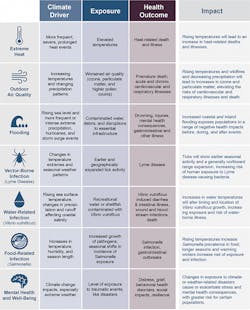New Climate Change Report Discusses Impact on Health and Safety of Workers
Climate change can affect human health in two main ways: first, by changing the severity or frequency of health problems that are already affected by climate or weather factors; and second, by creating unprecedented or unanticipated health problems or health threats in places where they have not previously occurred.
A new report, “U.S. Global Change Research Program Climate and Health Assessment,” provides a comprehensive overview of the potential health effects of climate change across the United States. The report includes a section on populations of concern, including outdoor workers and workers who may be exposed to other extreme weather environments. Worker health issues also are included in other sections of the report as part of broader discussions regarding the public health impact of climate change.
According to the report, climate change may increase the severity and prevalence of known occupational hazards, as well as the development of new hazards. Most at risk are outdoor workers, who include agriculture workers, commercial fishermen, construction workers, transportation workers and first responders. Workers in hot indoor environments such as warehouses and factories also are at risk.
In the summary of the report, the authors noted: “Current and future climate impacts expose more people in more places to public health threats. Already in the United States, we have observed climate-related increases in our exposure to elevated temperatures; more frequent, severe or longer-lasting extreme events; degraded air quality; diseases transmitted through food, water and disease vectors (such as ticks and mosquitoes); and stresses to our mental health and well-being.”
They go on to say that almost all of these threats are expected to worsen with continued climate change. “Some of these health threats will occur over longer time periods, or at unprecedented times of the year; some people will be exposed to threats not previously experienced in their locations,” said the authors.
They also noted that the benefits of climate change – such as fewer cold-related deaths in specific regions, will be outweighed by the increase in heat-related deaths in other regions.
The risk workers face from climate change includes working in hotter temperatures and the possibility of longer spans of hot days for outdoor work. These kinds of exposures can cause heat-related illnesses, as well as stress and fatigue, which can put workers at risk for injury. Workers also may have less control over their exposures to climate change-related risks than the general public.
In addition to heat exposures, the authors note that changes in climate patterns can cause increasingly frequent and severe weather extremes such as storms, flooding and drought. Warmer and dryer conditions also have increased the duration of the wildland fire season. This may result in an increased need for emergency response resources, further straining the nation’s responders both physically and psychologically.
About the Author

Sandy Smith
Sandy Smith is the former content director of EHS Today, and is currently the EHSQ content & community lead at Intelex Technologies Inc. She has written about occupational safety and health and environmental issues since 1990.

